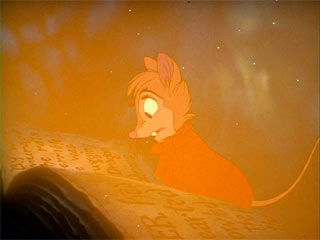ABOUT
THE MUSIC:
Working with Jerry Goldsmith
 AM:
I'm curious to learn how Jerry Goldsmith became attached to
the project. After all those months working through such independent
means, it must have been an eye-opening experience to have
brought a composer like him on board.
AM:
I'm curious to learn how Jerry Goldsmith became attached to
the project. After all those months working through such independent
means, it must have been an eye-opening experience to have
brought a composer like him on board.
DBS:
We wanted Jerry Goldsmith from the start. We chose many of
his cues from other film scores that he had done in the past
to create a temp underscore for NIMH as we we're making the
film. We approached Jerry's agent in January of 1982 and did
a deal with him to write the underscore for the film. At first
he refused to look at the film with our temp music, but after
his music editor saw the film and heard the temp score we
pasted together, he encouraged Jerry to look at the film with
the music we assembled. He was very impressed with what he
saw...and heard, and became very passionate about this film.
AM:
What was it like to collaborate with him? I believe 1982 was
a busy period for him; he did SIX film scores that year alone!
DBS:
He had 15 weeks to write the score and collaborate on the
the two songs, the lullabye and "Flying Wings"
(sic; the song is actually called "Flying Dreams")
with writer/singer Paul Williams. He would call us and play
his musical sketches. He would lay the phone down on his grand
piano and play the themes for us. It was thrilling to us.
We were working with Jerry Goldsmith!!! He loved the project
and what we were doing.
AM:
How did you feel when you heard the music performed for the
first time?
DBS:
I (Goldman) cried the first time I heard the London Philharmonic
Orchestra play his music for NIMH. It was easy to recognize
each music cue, because of those sessions on the phone and
at Jerry's house.
 AM:
I understand Goldsmith once said that NIMH was among his personal
favorite film scores, and he really enjoyed the experience.
AM:
I understand Goldsmith once said that NIMH was among his personal
favorite film scores, and he really enjoyed the experience.
DBS:
At our crew screening at the completion of the film, Jerry and
his wife, Carol, came out of the screening with tears in their
eyes. Jerry commented that "had I seen the whole film in color
before starting, I would have painted you a different score."
I still get goose bumps when I listen to the 8 minute music
cue, "The Tractor". I too, think that this is one of
Jerry's best. When we went to London to record the score, he
was still writing the score in the early mornings and late at
night, before and after the daily recording sessions. He told
me that he truly loved the movie.
AM:
Is it true that he was instrumental in introducing Spielberg
to NIMH, which paved the way for AMERICAN TAIL?
DBS: Jerry did introduce the film to Steven Spielberg, and we
subsequently met with him and eventually -- 2 years later --
did An American Tail with Steven. Jerry was to do the
score for that film too, but had to bow out because of a heavy
schedule in 1986. James Horner was invited in to do the score.
AM:
I always felt it was a shame you guys didn't collaborate with
him again.
DBS:
Jerry stayed in touch after that, calling us regularly at our
Dublin animation facility back in '87 thru '89. However, we
never worked with him again. We met at the Hollywood Bowl in
1997 when 20th Century Fox had a concert playing the music of
20th Century Fox, where Jerry had written many scores. We wish
we had worked with him more, much more. He was a lovely, lovely
man.
... I (Gary Goldman) have his hand-drafted lead sheet to the
Main Title cue signed, "I love you Mrs. Brisby. Jerry
Goldsmith". It is framed and hanging, and lit in a special
alcove in my home.